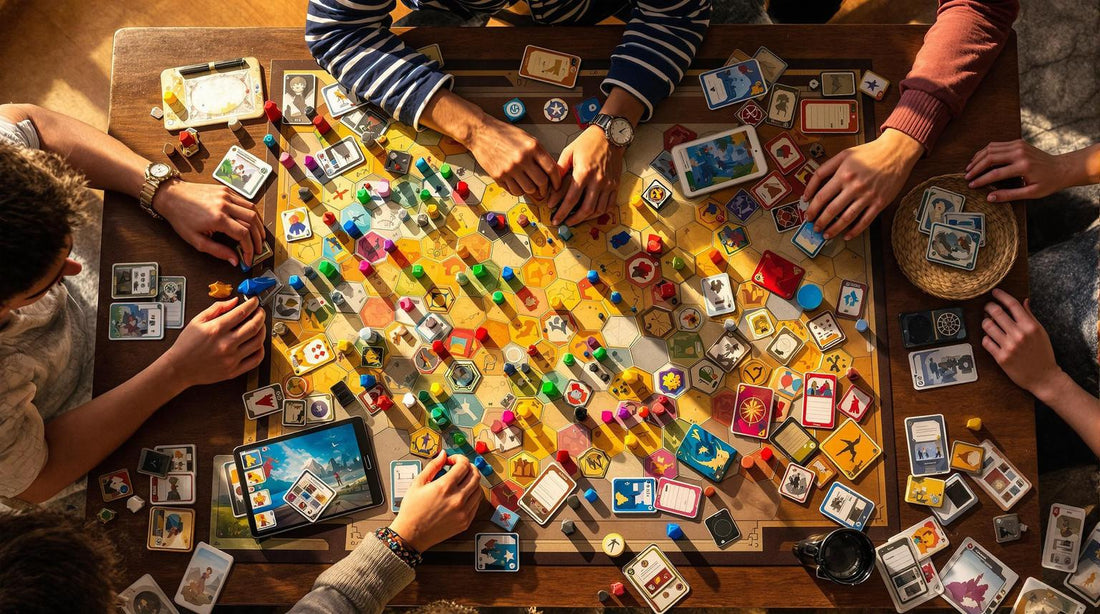Discover the Best Board Games for Every Player

Game Theory in Sequential Board Games: Key Insights
Game theory helps you make smarter moves in board games by predicting opponents’ actions and planning ahead. Whether it’s chess, Jenga, or Settlers of Catan, understanding how decisions affect future outcomes is key to winning. Here’s what you need to know:
- Think Ahead: Use forward planning to predict future moves and backward analysis to work from the end goal.
- Open vs. Hidden Information: Games like chess (open) let you see everything, while games like Catan (hidden) add unpredictability.
- Key Techniques: Backward induction, strategic interdependence, and payoff maximization help you map out the best moves.
- AI in Games: Modern AI analyzes strategies and opponents, making games more challenging and fun.
| Game Type | Focus | Key Strategy |
|---|---|---|
| Chess | Move Planning | Backward Induction |
| Settlers of Catan | Resource Management | Analyzing Hidden Info |
| Diplomacy | Alliances & Betrayal | Balancing Risks & Rewards |
Game theory applies to every stage of a game, from early moves to endgame tactics. Ready to improve your gameplay? Let’s dive deeper.
Guide to Game Theory - minimax and backward induction
Main Game Theory Concepts
Game theory plays a key role in shaping decisions in sequential board games, relying on several core principles to guide player strategies.
Hidden vs. Open Information
The amount of visible information in a game directly affects strategic choices. In open-information games like chess, players can see everything - pieces, positions, and potential moves. On the other hand, games with hidden information add layers of unpredictability and challenge.
"Hidden information allows you to notably increase the complexity of a game, by giving players many more options to consider, but does it in a way that's invisible to the casual player, thus offering the best of both worlds: playability and strategy." - Shannon Appelcline
Here’s how hidden information plays out in some games:
| Game | Hidden Element | Strategic Impact |
|---|---|---|
| Gin Rummy | Opponent's cards | AI using inference achieves 60% win rate |
| Settlers of Catan | Resource cards | Introduces dynamic trading subgames |
| Galactic Emperor: Hegemony | Fleet movements | Enables deceptive positioning |
This balance between hidden and visible information shapes how players structure their strategies and plan their moves.
Best Move Sequences
Building strategies often involves identifying the best move sequences. This requires analyzing potential outcomes and anticipating how opponents might respond. Game theory addresses this through two principles: strategic interdependence (how decisions affect others) and payoff maximization (choosing moves that yield the best results).
"Game theory is the scientific study of strategically interdependent decision making." - William Spaniel
Planning Moves in Reverse
Backward induction is a crucial technique for mapping out optimal moves. Instead of focusing only on the immediate next step, players work backward from the desired end-game scenario. This method ensures that decisions align with long-term goals.
The process involves:
- Analyzing possible end-game scenarios
- Pinpointing the best possible final moves
- Tracing the decision tree backward
- Selecting current moves based on future outcomes
Game Theory in Action
Chess: Move Planning
Chess, a game of perfect information with an estimated 10^120 possible move sequences, requires players to think strategically to navigate its immense complexity. The minimax algorithm is a cornerstone of chess strategy, helping players limit potential losses, aim for gains, anticipate their opponent's moves, and assess the strength of their position.
"Game theory provides a robust framework for analyzing chess, offering insights into optimal strategies, decision-making processes, and the fundamental nature of the game."
Modern chess engines take this concept even further, blending minimax algorithms with machine learning to evaluate positions and recommend moves. Human players also use game theory through tools like:
- Opening databases: Study established lines to reduce risks early in the game.
- Position evaluation: Weigh potential outcomes to decide when sacrifices are worthwhile.
- Pattern recognition: Analyze opponents' tendencies to predict their likely responses.
These tools highlight the balance between pure strategy and adaptability, setting the stage for games with added layers of uncertainty.
Sequence: Card and Board Tactics
Sequence builds on the strategic clarity of chess but introduces the complexity of probability. Players must manage two key aspects:
- Card probabilities: Maximizing the likelihood of drawing useful cards.
- Strategic placement: Deciding where to place pieces for both short-term gains and long-term positioning.
The game's dual nature forces players to juggle immediate tactical opportunities with broader strategies. Success hinges on understanding how card probabilities influence board decisions, echoing principles seen in games like Penney’s game.
Diplomacy: Player Interaction
Taking game theory into the realm of negotiation, Diplomacy focuses on alliances and player dynamics. Set in pre–World War I Europe with 34 power centers, the game presents scenarios that demand both collaboration and betrayal.
"According to game theory, the best way to play a game is to maximize one's minimum gains -- assume that the enemy is a perfect player and move accordingly." – Lewis Pulsipher
Different types of games within Diplomacy require distinct strategies:
| Game Type | Focus | Example Application |
|---|---|---|
| N-person zero-sum | Achieving overall victory | Long-term planning |
| 2-person zero-sum | Direct conflicts | Tactical decisions |
| Cooperation games | Building alliances | Sharing resources |
Winning in Diplomacy requires careful expansion, smart unit positioning, and balancing immediate actions with future plans. Lone units can be used effectively to disrupt opponents, while shifting alliances and evolving power dynamics keep players reevaluating their strategies.
sbb-itb-1ed942f
Research Findings
The following research findings provide additional insights into the strategies discussed earlier.
First Player Effects
Research shows that the advantages of moving first depend on the type of game and the information available. For example, a study analyzing professional golf data from 2003 to 2018 revealed that when two players were within 2 feet of each other on the putting green, the first player typically ended up about 5 inches farther from the hole than the second player. This outcome highlights a second-mover advantage, as the second player can observe and learn from the first player’s attempt.
Phase-Based Tactics
Strategies often evolve throughout different stages of a game, guided by selection function frameworks. Breaking the game into phases allows players to concentrate on distinct goals, such as gathering resources early on, securing strong positions in the middle, and converting those advantages into success at the end. Studies confirm that sequential decision-making tends to outperform simultaneous moves. For instance, in Machine Cost Sharing Games, the sequential price of anarchy improves dramatically, reaching O(log(n)) compared to O(n) in simultaneous setups. These findings align with earlier discussions on planning ahead and analyzing outcomes backward.
Now vs. Later Decisions
Deciding between immediate actions and long-term strategies requires players to consider both their opponents' reactions and future opportunities. In dictator game experiments, about 50% of participants chose to keep all the money for themselves, 5% split it equally, and 45% gave a smaller portion to the other participant. This illustrates how players weigh the benefits of instant rewards against the potential for better positioning in the future.
What's Next in Game Theory
AI in Board Games
Artificial intelligence is changing the way strategies are developed and analyzed in sequential board games. Instead of creating unbeatable opponents, modern AI aims to provide challenging yet enjoyable gameplay. This lets human players improve their skills while competing against unpredictable but winnable opponents.
"In turn-based games, strategic insight triumphs over raw speed, as experienced players consistently outmaneuver current AI systems."
Today's AI uses advanced scoring systems to assess factors like defense, offense, and resource management, adjusting strategies on the fly. For example, in 4X space strategy games, AI might retreat ships for repairs or shift attack plans based on evolving game conditions.
New Decision Mechanics
AI advancements are also influencing the way decisions are made in board games. Game theory research is driving fresh approaches to game design, particularly in scenarios with imperfect information. Recent algorithms combine limited look-ahead solving with opponent modeling, outperforming older methods in complex situations.
These innovations push players to:
- Analyze opponents' behavior.
- Adjust strategies despite incomplete information.
- Weigh long-term outcomes of their choices.
- Manage risks and rewards in ever-changing scenarios.
Teaching Through Games
Educational game design is taking cues from these strategic advancements to create interactive learning experiences. A great example is Sylviculture, a card game designed by students Shannon Lin, Jasper Chattra, and Ramey Harper-Mangels. This game teaches players about ecosystem development by incorporating concepts like primary species and climax communities into its strategic gameplay.
Game theory matrices are now being applied to create balanced educational games. These games encourage players to optimize their decisions, helping them develop skills like strategic thinking, resource management, and even social-emotional awareness.
Summary
Key Concepts Review
Sequential game theory focuses on making the best decisions by analyzing move sequences. A core method here is backward induction, which helps determine the optimal moves by working backward from the desired outcome. This approach, first introduced by Claude Shannon in 1950 while discussing chess programming, is a powerful way to map potential outcomes and plan strategies.
These ideas lay the foundation for practical strategies you can apply in gameplay.
Using These Ideas
Here are some ways to put these concepts into action and improve your gameplay:
- Visualize Your Moves: Picture the sequence of decisions and their possible outcomes.
- Start from the End: Work backward from your desired result to plan your moves.
- Time Your Strategy: Adjust your approach based on whether you have the first- or second-mover advantage.
| Game Type | Strategic Focus | Key Theory Application |
|---|---|---|
| Perfect Information (Chess) | Move Planning | Backward Induction |
| Hidden Information (Secret Hitler) | Social Deduction | Analyzing Incomplete Information |
| Economic (Settlers of Catan) | Resource Management | Opportunity Cost Analysis |
Explore Games at Brain Games
Looking to test these strategies? Check out Brain Games, a store offering a variety of board games that bring these concepts to life. From timeless classics with perfect information to modern games with hidden elements, you'll find something to challenge your strategic skills. Visit Brain Games to discover games that match your interests and skill level.
Their collection includes both traditional and modern games, all designed to help you apply game theory in engaging and practical ways.






